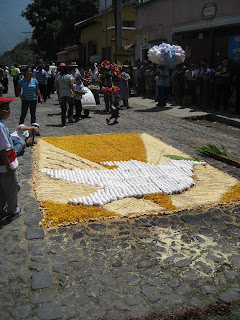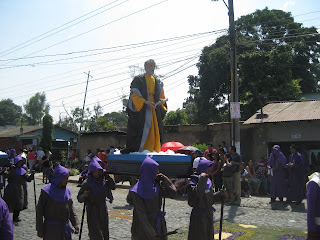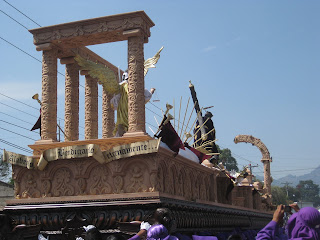Saturday, April 23, 2011
Finally...
It's 3:00 a.m. on Saturday and the last procession for Santo Viernes (Holy Friday, what we call Good Friday) has just passed our front door. They began their route from Escuela de Christo Church, about two blocks away from us at 4:00 p.m. yesterday. We actually saw them pass by twice today. The first time was as we were leaving the two-hour Santo Viernes service at San Francisco El Grande Church. They were passing the front gate of the courtyard and no one could get out. We had to wait until they had passed (about 30 minutes) to exit the church yard (it's surrounded by a high wall). While waiting or as we were leaving, my shoulder bag was cut by a thief. I imagine they were surprised. It only held a Spanish hymnal (we sang with the choir again) and two paperback missals (Spanish and English). I'll get the pictures posted as soon as possible. I'm only about two weeks behind, if I remember correctly. Fortunately, there is only one procession on Santo Sabado (Holy Saturday).
Wednesday, April 20, 2011
Los Bomberos
La Antigua has a volunteer fire department, as do most Guatemalan towns and villages, at least those that have fire departments. Firemen are called bomberos and they don't set off bombs.
Of course, being Guatemala, they have their own statue of Jesus.
They also have fire equipment and dogs to protect it. I didn't get a picture of him, but we also saw a dalmatian, one of the official fire department dogs.
They also have fire equipment and dogs to protect it. I didn't get a picture of him, but we also saw a dalmatian, one of the official fire department dogs.
Strange Fellows
One Saturday, Linda and I went to Guatemala City by chicken bus. On our way back, we got off at the entrance to La Antigua and noticed these two strange fellows, who were against the side of a small building built over the Rio Pensitivo.
The first two lines are in Latin and translate as "I prefer to die than to be dishonored." The remainder, in Spanish, translates as "Secret password used by the Nazarenes (one of the brotherhoods who organize the processions and carry the processional barges) described by Pepe Milla (famous 19th. Century Guatemalan author)." Now, if the password is supposed to be secret, I wonder why Pepe (nickname for José, i.e. Joseph) felt the need to reveal it and why someone else decided to place it on a statue?
Tallest Tree
Here is a picture of the tallest tree in La Antigua. It's inside a walled-in garden. There are a few more trees to the left. There are other trees in La Antigua, such as in the parks and many of the enclosed city estates. Of course, there are trees on the surrounding hills and volcanoes, although you often see burning going on outstide the city, where farmers are clearing space to plant.
Take a Letter
This was something that I had never seen in La Antigua - a postal carrier. He gets around on that bicycle propped on the curb.
Cuarto Domingo de Cuaresma
The Fourth Sunday of Lent featured a procession by the Church of Santa Ana in nearby Santa Ana.
Like all processions, there were a lot of creative and beautiful alfombras. This one had a dove created with egg shells (the insides had been blown out).
Most are very colorful.
Geometrics are popular,
as are more traditional religious themes.
Much work goes into creating an alfombra and it all done for the intrinsic reward. There is no judging and no prizes.
This one worried me. It had a statue of Jesus, the good shepherd in the center, with about a hundred plastic sheep spread out over the alfombra.
These saints are patiently waiting for the procession to start.
The Roman soldiers appear and the procession begins.
The saints are picked up and carried forward.
Following the saints are a number of statues of Jesus depicting various parts of the Bible story.
Every procession is preceeded by an old man playing a small drum and blowing a Mayan flute.
Here come more Roman soldiers.
The main processional barge approaches.
Sixty men carry the heavy barge.
Even daughters get in on the action.
The central figure is Jesus carrying his cross.
The processional barge moves on.
The first of the two bands follow the first processional barge. At this time, the second band was playing.
How sad! Only three tubas!
The women's processional barge approaches.
Something seems strange.
It's being carried by young men. Evidently they didn't have enough women to carry it.
Two smaller statues of saints follow.
The second band is still playing.
Wheeled tympani are used in all the bands.
This young man may look out of place, but his is all Maya. I'm told that there are frequent cases of albinism in the Maya villages.
Following the procession, the alfombras are cleaned up.
They carry away all the debris in trucks like this.
Later, that same day, about 9:30 p.m., the same procession passed right by our front door. As with the start of the procession that morning, there were alfombras on the streets.
The statues and processional barges are now lighted.
The only addition is the generator to power the lights.
Vendors are still selling. The cleaning crew is still cleaning.
The end.
Like all processions, there were a lot of creative and beautiful alfombras. This one had a dove created with egg shells (the insides had been blown out).
Most are very colorful.
Geometrics are popular,
as are more traditional religious themes.
Much work goes into creating an alfombra and it all done for the intrinsic reward. There is no judging and no prizes.
This one worried me. It had a statue of Jesus, the good shepherd in the center, with about a hundred plastic sheep spread out over the alfombra.
These saints are patiently waiting for the procession to start.
The Roman soldiers appear and the procession begins.
The saints are picked up and carried forward.
Following the saints are a number of statues of Jesus depicting various parts of the Bible story.
They start them young here.
Every procession is preceeded by an old man playing a small drum and blowing a Mayan flute.
Here come more Roman soldiers.
The main processional barge approaches.
Sixty men carry the heavy barge.
Even daughters get in on the action.
The central figure is Jesus carrying his cross.
The processional barge moves on.
The first of the two bands follow the first processional barge. At this time, the second band was playing.
How sad! Only three tubas!
The women's processional barge approaches.
The smaller processional barges carried by women always feature a statue of the Blessed Virgin.
It's being carried by young men. Evidently they didn't have enough women to carry it.
Two smaller statues of saints follow.
The second band is still playing.
Wheeled tympani are used in all the bands.
This young man may look out of place, but his is all Maya. I'm told that there are frequent cases of albinism in the Maya villages.
Following the procession, the alfombras are cleaned up.
They carry away all the debris in trucks like this.
Later, that same day, about 9:30 p.m., the same procession passed right by our front door. As with the start of the procession that morning, there were alfombras on the streets.
The only addition is the generator to power the lights.
Vendors are still selling. The cleaning crew is still cleaning.
The end.
Subscribe to:
Comments (Atom)





















































